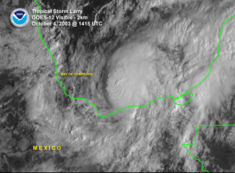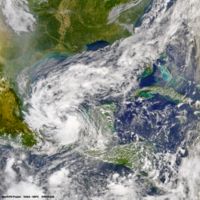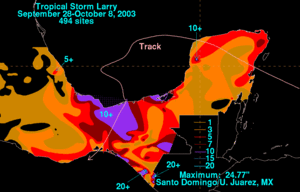Tropical Storm Larry (2003)
2007 Schools Wikipedia Selection. Related subjects: Storms
| Tropical storm ( SSHS) | ||
|---|---|---|
|
Tropical Storm Larry near landfall |
||
| Formed | October 1, 2003 | |
| Dissipated | October 6, 2003 | |
| Highest winds |
|
|
| Lowest pressure | 993 mbar ( hPa) | |
| Damage | $53.6 million (2003 USD) $59 million ( 2005 USD) |
|
| Fatalities | 5 direct | |
| Areas affected |
Mexico, El Salvador | |
| Part of the 2003 Atlantic hurricane season |
||
Tropical Storm Larry was the twelfth tropical storm in the 2003 Atlantic hurricane season. It was one of eight storms to impact Mexico between the Atlantic Ocean in the season, a near-record. Larry formed in early October from an extratropical storm in the Bay of Campeche, and reached a peak intensity of 65 mph (100 km/h). Due to weak steering currents, the storm southward, resulting the storm to hit the Tabasco coastline, the first Tabascan landfall since Tropical Storm Brenda in 1973.
Larry drifted across the Isthmus of Tehuantepec, dropping heavy rainfall of over nine inches in places. The rainfall led to flooding and mudslides, causing damage to thousands of houses. The flooding killed five people and resulted in $53.6 million (2003 USD, $59 million 2005 USD) in damage. Larry was one of three tropical cyclones to hit Mexico in a short period of time, including Tropical Depression Nora and Tropical Storm Olaf in the eastern Pacific Ocean.
Storm history
A tropical wave moved off the coast of Africa on September 17. It moved across the shear-ridden Atlantic Ocean without development, and remained disorganized until reaching the western Caribbean Sea on September 26. There, the wave situated itself beneath an upper level anticyclone, allowing for favorable upper level outflow and for deep convection to develop. On the 27th, a low pressure area developed while the system was located a few hundred miles to the east of the Yucatán Peninsula. The system continued to organize, and nearly developed into a tropical depression before moving ashore on the Yucatan Peninsula on September 29.
Dry air and land weakened the tropical wave, and when the area entered the Bay of Campeche, it merged with a stationary frontal boundary. Cool, dry air around the system caused the system to develop a cold core, and the area organized into an extratropical low on September 30. A large high pressure system over the northern Gulf of Mexico forced the system southward, where deep convection developed significant convection. The system developed a warm core, and on October 1 the storm organized into Tropical Storm Larry while located 300 miles east-southeast of Tampico, Mexico.
Weak steering currents allowed for Larry to drift westward at 2 mph while marginally favorable conditions allowed the storm to strengthen to a peak of 65 mph on October 3. A mid-level ridge forced the storm more to the south-southeast, where after remaining a 60 mph storm for three days, Larry made landfall on Paraíso in the Mexican province of Tabasco on October 5. It steadily weakened over land, and degenerated into a remnant low on October 6 while mid-way through the Isthmus of Tehuantepec. The remnant low turned to the southwest, and reached the eastern Pacific Ocean on the 7th. The remnants of Larry re-organized in the eastern Pacific, with the National Hurricane Centre indicating for the possibility of redevelopment into a tropical depression on October 9. However, the convection diminished, and further development was no longer anticipated.
Preparations
Due to its erratic motion, the Mexican government issued a Tropical Storm Warning and a Hurricane Watch early in Larry's lifetime from Vera Cruz to Campeche. The watches and warnings were extended westward to Tuxpan on the 4th and extended eastward to Cuidad del Carmen on the 5th. Due to the threat of the storm, officials closed three Pemex oil ports. The company used its reserves to make sure profits weren't disrupted. In addition, the storm closed shipping ports in Dos Bocas in Tabasco, Coatzacoalcos in Veracruz, and Cayo Arcas in Campeche. The Mexican government placed six coastal states on maximum alert, while authorities set up 75 evacuation shelters for around 1,500 people. Because of the storm, the government declared much of eastern Mexico as a state of emergency.
Impact
Tropical Storm Larry was one of eight storms to hit Mexico from either the Atlantic Ocean or the Pacific Ocean, the highest since the record of nine in 1971. The National Hurricane Centre expected the storm to produce a storm surge of 3 to 5 feet, with high waves on top, though no official surge readings were reported. The highest recorded winds on land were 59 mph (95 km/h) in El Alacrán in Tabasco. The worst of Larry's effects came from its rainfall, peaking at 24.77 inches (629.2 mm) in Upper Juarez in southeastern Mexico. The highest 24 hour rainfall total was 9.6 inches (245.5 mm) in Tortuguero, Chiapas in 24 hours, while several other locations reported over 4 inches in 24 hours.
The flooding damaged more than 21,000 houses across Mexico, in combination with the damage from Eastern Pacific Hurricanes Nora and Olaf. Damage was greatest around the Chipas capital of Tuxtla Gutiérrez, where over nine thousand houses were affected. The rainfall caused mudslides across the country, hospitalizing two individuals in central Hidalgo. The flooding also caused severe crop damage along Larry's path. Strong wind gusts caused outages to telephone and power services. In all, Larry caused 5 deaths and $53.6 million in damage (2003 USD, $59 million 2005 USD).
In El Salvador, rainfall from the remnants of Larry, combined with previous rainfall, caused mudslides and flooding, forcing several thousand people to evacuate in San Salvador. The flooding destroyed or damaged hundreds of houses.
Aftermath
Tropical Storm Larry hit Mexico at around the same time as two other tropical storms. The Mexican Red Cross provided aid for 6,587 families throughout the country, while the International Federation of Red Cross and Red Crescent Societies launched an international appeal for aid. The appeal raised $284,472.8 (2003 USD). The Mexican Red Cross distributed 4,000 food and hygiene packets to various places, and delivered 2,750 family packets and over 4,300 mattresses to citizens in Chiapas. 5,000 school kits were distributed, as well. A total of 38,750 people benefited from the operation.
The name Larry was not retired and is scheduled to be used next during the 2009 season.



